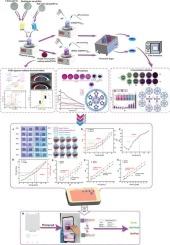pH和花青素浓度对壳聚糖基膜结构的共同调节,用于开发冷鲜羊肉的新鲜度指示标签
IF 9.8
1区 农林科学
Q1 CHEMISTRY, APPLIED
引用次数: 0
摘要
本研究考察了壳聚糖-二醛淀粉/聚乙烯醇(CDS/PVA)的pH值(pH = 4.2,5.2,5.6)和紫薯花青素(PSPA;0.5, 1.0, 1.5, 2.0 mg/mL)进行调节,得到新型比色膜[(PSPA-CDS/PVA)pH=x]。红外光谱和x射线衍射分析表明,膜组分相互兼容。随着pH值的增加,膜的抗拉强度从58.850 MPa下降到23.052 MPa,水氧屏障减弱(27.624 ~ 38.406 g·m−2·h−1和0.144 ~ 0.188 cm3·cm·m−2·day−1·atm−1);P <; 0.05),促进挥发性氨在膜内的渗透。PSPA浓度为1.5 mg/mL时,膜具有较好的氨响应显色性和显色稳定性。1.5 mg/mL (ppa - cds /PVA)pH=5.6的颜色在羊肉冷藏过程中由紫红色变为蓝绿色,准确指示了羊肉的新鲜度和腐败程度。使用微信小程序也可以成功地监测颜色信号。本文章由计算机程序翻译,如有差异,请以英文原文为准。

Co-adjustment of chitosan-based film structure by pH and anthocyanin concentration for the development of reshness-indicating labels on chilled mutton
In this study, the pH values (pH = 4.2, 5.2, 5.6) of chitosan-dialdehyde starch/polyvinyl alcohol (CDS/PVA) and the concentrations of purple sweet potato anthocyanins (PSPA; 0.5, 1.0, 1.5, 2.0 mg/mL) were adjusted to obtain a novel colourimetric film [(PSPA-CDS/PVA)pH=x].The infrared spectroscopy and X-ray diffraction showed that the film components were compatible with each other. Additionally, the structure of the films loosened as the pH increased because their tensile strength decreased from 58.850 MPa to 23.052 MPa and the water‑oxygen barrier was weakened (27.624 to 38.406 g·m−2·h−1 and 0.144 to 0.188 cm3·cm·m−2·day−1·atm−1; p < 0.05), promoting volatile ammonia penetration within the films. The films showed better ammonia-responsive colour development and colour stability at a PSPA concentration of 1.5 mg/mL. The colour of 1.5 mg/mL (PSPA-CDS/PVA)pH=5.6 changed from purplish-red to bluish-green during mutton refrigeration, accurately indicating mutton freshness and spoilage. The colour signals could also be monitored successfully using the WeChat applet.
求助全文
通过发布文献求助,成功后即可免费获取论文全文。
去求助
来源期刊

Food Chemistry
工程技术-食品科技
CiteScore
16.30
自引率
10.20%
发文量
3130
审稿时长
122 days
期刊介绍:
Food Chemistry publishes original research papers dealing with the advancement of the chemistry and biochemistry of foods or the analytical methods/ approach used. All papers should focus on the novelty of the research carried out.
 求助内容:
求助内容: 应助结果提醒方式:
应助结果提醒方式:


